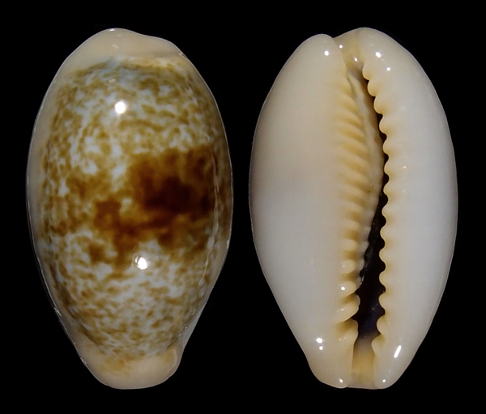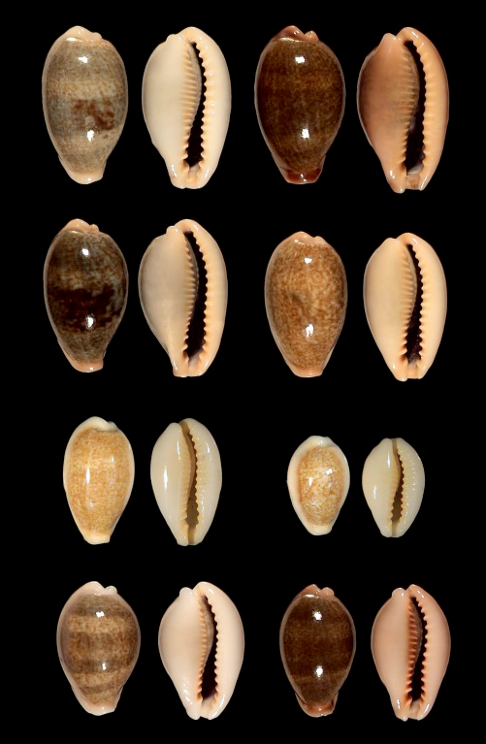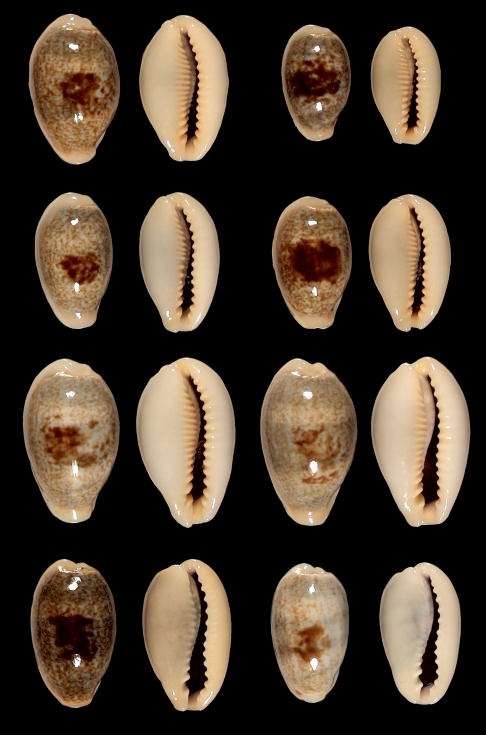Erronea ovum erici Lorenz, Bridges & Chiapponi 2011:
A Brief Discussion
by Randy Bridges
The discovery and ultimately the description of molluscs new to science is as exciting as it is never-ending. In this brief note I will introduce a recently described subspecies of Erronea ovum (Gmelin 1791). Most of the information is excerpted from our original description (Lorenz, Bridges & Chiapponi, 2011). This new subspecies is poorly, if at all, represented in most collections.
Erronea ovum erici can be characterised by the following features:
I. Small size and calloused, with calloused blunt extremities.
II. The presence of a dark and normally compact dorsal blotch.
III. Thick and densely set columellar teeth when compared to the related species.
IV. Rather weak color staining between the teeth.
When compared to a larger series of specimens from the E. ovum complex, from a variety of collecting locales, these distinguishing characteristics become more apparent. All of these features can be readily observed when examining the specimen shown in Figure 1.

Fig. 1. Erronea ovum erici, paratype 10, 18.5 mm.
The geographic distribution of E. o. erici and its relatives is still under investigation. When the population from the type locality was discovered by Lorenz in 2006, "a narrow channel between Gaya Is. and Sapi Is. (Locus typicus, 6°00’41’’N 116°00’29’’E), offshore Kota Kinabalu, Sabah, Malaysia", similar specimens were only known from the south of Palawan, Philippines. Further exploration of the Malaysian type locality 3 years later failed to turn up any specimens, due to habitat destruction. Additional specimens have since been discovered in other areas within a restricted range from the type locality, but it still remains an elusive cowry. Our original distribution map is reproduced here in Figure 2.

Fig. 2. Distribution map of Erronea ovum ovum (green), E. o. palauensis (yellow), E. o. erici (red) and E. chrysostoma (blue).
It is not uncommon when researching a new taxon to also revise the taxonomic status and hierarchy of its relatives. This was exactly the case for us when researching the E. ovum complex. With the publication of his landmark mtDNA studies on the Cypraeidae, Meyer (2004) provided additional insight into the order of relationships among the various cowry groups. As a result of this additional data, we raised the status of the subspecies, E. o. chrysostoma, to that of species, E. chrysostoma, based upon both genetic and conchological traits.
In the two plates shown below, the various species and subspecies making up the E. ovum complex are illustrated for comparison. You should easily recognize the salient features characterising the various taxa. It is my hope that you enjoyed this (very) brief look at this rare and interesting new subspecies. Comments and questions are always welcome.

Plate 1. Row 1: left: E. ovum ovum, 33 mm. Samar, Philippines. Right: 33 mm. Bohol, Philippines. Dark form.
Row 2: left: E. ovum ovum, 32 mm. Cebu, Philippines, exceptionally dark blotched shell. Right: 31 mm. Kangean Is., Java Sea.
Row 3: E. ovum palauensis, 25 and 20 mm, Palau Is.
Row 4: E. chrysostoma, both 28 mm. Solomons.

Plate 2: Erronea ovum erici.
Row 1: left: holotype, 21 mm coll. MNHN. Right: paratype 5, 17 mm.
Row 2: left: paratype 7, 19 mm coll. Mont. Right: paratype 9, coll. Chiapponi.
Row 3: left: E. ovum erici, 23 mm, Balabac Island, Palawan. Right: E. ovum ovum, 23 mm, exceptionally calloused look-alike specimen from Samar. Note the structural differences in the dentition, especially on columellar side, and the formation of the columellar peristome, the less condensed blotch and the less blunt extremities in E. ovum ovum.
Row 4: Erronea errones. Left: 21 mm, Broome, NW Australia. Specimens from this area are confusingly similar to E. ovum. The abruptly widening anterior end of the aperture and the pronounced last anterior teeth is still obvious though. Right: E. errones, 20 mm, New Caledonia. In most populations of E. errones the different formation of the anterior is more defined.
References
LORENZ, F., BRIDGES, R.J. & CHIAPPONI, M. (2011). A close look at Erronea ovum (Gmelin, 1791) with the description of a new subspecies (Gastropoda: Cypraeidae). Conchylia 41(2): 2-9.
MEYER, C. (2004): Toward comprehensiveness: increased molucular sampling in Cypraeidae and its phylogenetic implications. Malacologia, 46(1): 127-156.
